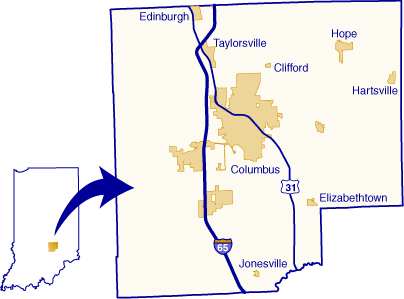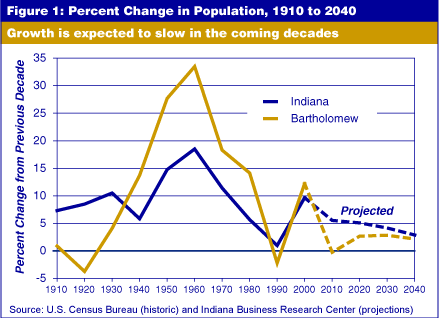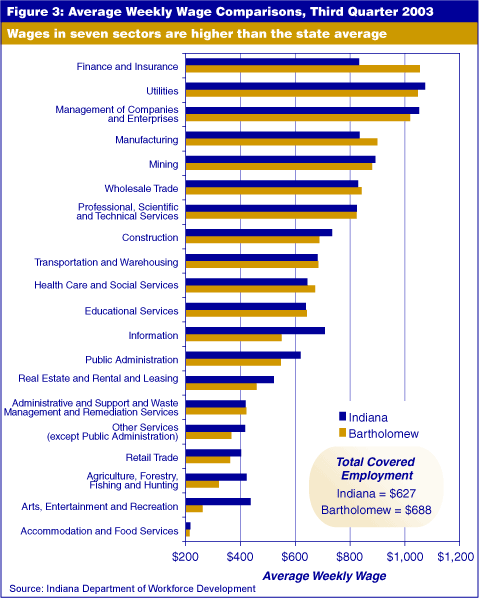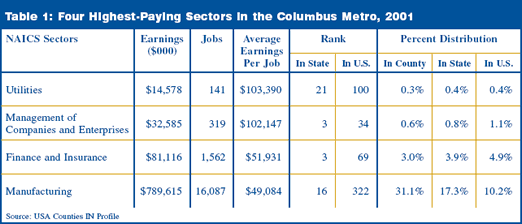The Columbus Metro Area
The Area
Known for its distinctive buildings and proclaimed by some to be an “architectural Mecca,” the Columbus Metropolitan Statistical Area (metro), consisting of Bartholomew County in south-central Indiana, was one of two new Indiana metros added by the federal government. Bisected by I-65 and U.S. 31, the Columbus metro lies just southeast of Indianapolis. When looking at combined statistical areas (CSAs), as defined by the Office of Management and Budget, Bartholomew County is absorbed into the Indianapolis-Anderson-Columbus CSA.

Compared to the rest of the state, Columbus is prosperous and well-educated. Twenty-two percent of Bartholomew County adults over age 25 have a bachelor’s degree or higher, ranking it 12th in the state. Per capita personal income for 2001 ranked eighth. The median home value was $105,300 in 2000, ranking it 14th among the 92 counties, and the total assessed property value per capita ranked seventh.
Population Trends
The Columbus metro area had 72,341 residents, according to estimates for 2003, a growth of 1.3 percent since Census 2000. While this rate was less than the state’s 1.9 percent increase, Bartholomew County surpassed Grant County to become Indiana’s 20th largest county.
While the decennial percent change in population peaked in 1960, Columbus continued to grow at rates higher than the state, with the exception of the 2.2 percent decline during the 1980s (see Figure 1). Projections from the Indiana Business Research Center indicate a change in this trend, with Bartholomew County lagging behind the state. By 2010, the Columbus population is expected to drop 1.5 percent from current levels (a 0.2 percent decline from Census 2000), with the growth rate leveling out around 2.7 percent by 2020. However, it is worth noting that Bartholomew County has exceeded expectations so far. Projections indicated a decline of 557 people by 2005 from the Census 2000 figures, but Census Bureau estimates for 2003 show a three-year gain of 906.

Nevertheless, out-migration poses a challenge for Columbus. When looking at the change between Census 2000 and July 2003, natural increase (births minus deaths) caused Bartholomew County’s gain of 906 residents. Net migration for the area showed a decline of 234 people. Breaking the population change down further, the county showed a net gain of 806 through international migration, but a net loss of 1,040 through domestic migration. Out of Indiana’s 92 counties, only 15 exceeded Bartholomew County’s domestic migration losses. And 12 of those counties have larger populations (including seven of the 10 largest counties in the state), so the impact of the out-migration in those highly populated places decreases in significance.
Industrial Mix and Jobs
While the Columbus economy has diversified in recent years, manufacturing remains the dominant player in the region, accounting for nearly 35 percent of employment in third quarter 2003. And in typical Hoosier fashion, it’s the automotive industry playing the lead role.
Cummins Inc. was founded in Columbus 85 years ago and is the area’s largest employer. With corporate headquarters and its largest engine manufacturing facility in the city, about 4,500 of its 25,000 worldwide employees work in Columbus. While the recession proved problematic for the company, it is rebounding. In the past six months, Cummins added about 180 employees at its Columbus and Seymour locations and is gaining market share. According to Columbus’ newspaper, The Republic, Cummins was the only engine maker to meet 2002’s tougher emissions standards on time, thanks to improved technology, productivity increases and a new design approach. The company is already running 2007-compliant engines on the road, giving it a competitive edge in the coming years.
ArvinMeritor, created four years ago by the merger of Columbus-based Arvin Inc. with Meritor Automotive, is a global supplier of automotive exhaust and ride control components. Although the company is based out of Michigan, it remains one of the largest employers in the region. Its 48,000-square-foot North American Information Technology Center is located within the InfoTech Park, the state’s seventh Certified Technology Park.
Consisting of 67 acres at the municipal airport in northwest Columbus, the InfoTech Park is a business incubator adjacent to Indiana University–Purdue University Columbus, Ivy Tech State College and the planned $25 million, 124,000-square-foot Columbus Learning Center. Tata Consultancy Services, the India-based information technology and management consulting firm, also plans to build within the technology park.
Other expansions in the metro include Diamet, the automotive parts manufacturer, which plans to build a $1 million, 25,000-square-foot expansion and invest about $9.6 million in new equipment, and Toyota Industrial Equipment Manufacturing, which is adding 105,000 square feet to its facility at a cost of about $9.8 million. NTN Driveshaft is in the midst of a $12 million expansion involving the addition of 210,000 square feet and $41.9 million in machinery to double its production capacity. Moreover, the county’s fifth largest employer, Dorel Juvenile Group (maker of child-safety seats), recently opened its new $25 million state-of-the-art factory.
Aside from manufacturing, health care and social services comprised the next largest portion of area employment at 13 percent in the third quarter of 2003, followed by retail trade at 10 percent. When combined, these top three industries accounted for nearly 58 percent of the area’s 39,144 jobs.
As seen in Figure 2, Columbus drew in a significant number of workers from surrounding counties in 2002, in addition to the 43,442 people who both lived and worked in Bartholomew County. Of the 4,630 in the resident labor force who worked outside of the county, nearly 60 percent of those commuted into the Indianapolis metro.

Income and Wages
Many of those working in the Columbus metro earn more than the average Hoosier. Average weekly wages for third quarter 2003 were $61 higher than for the state, according to the Indiana Department of Workforce Development. On an industry basis, the differences ranged from arts, entertainment and recreation, averaging $175 less than Indiana, to finance and insurance at $222 more than the state average (see Figure 3).

Table 1 shows the annual figures from the U.S. Bureau of Economic Analysis for the four highest-paying sectors in Bartholomew County for 2001. Earnings for the management sector fall within the top 1 percent of counties nationwide, while those in finance and insurance land within the top 2 percent.

As mentioned earlier, per capita personal income (PCPI) for Bartholomew County ranked eighth in the state at $30,181 in 2001, exceeding Indiana’s $27,522 average. While this illustrates a 4.9 percent five-year growth from 1996 when adjusted for inflation, Bartholomew’s PCPI remained slightly less than the U.S. average of $30,413.
However, when looking at median household income from 2000, one sees almost the opposite: At $44,184, Bartholomew County’s median household income exceeded both the state and the nation (by 6.3 percent and 5.2 percent, respectively). When adjusted for inflation, this represents a 4.8 percent decline in Bartholomew County’s household income between 1995 and 2000. This made it the ninth fastest declining county in the state for that five-year period and ranked it in the bottom 11 percent of counties nationwide. So while the current Bartholomew County household still brings home more than the average American, that wouldn’t be the case if current declines in household income were to continue much longer.
- Columbus Economic Development Board
- Columbus: Different by Design
- Columbus (Bartholomew Co.) IN Depth Profile
Rachel Justis
Managing Editor, Indiana Business Research Center,
Kelley School of Business, Indiana University
